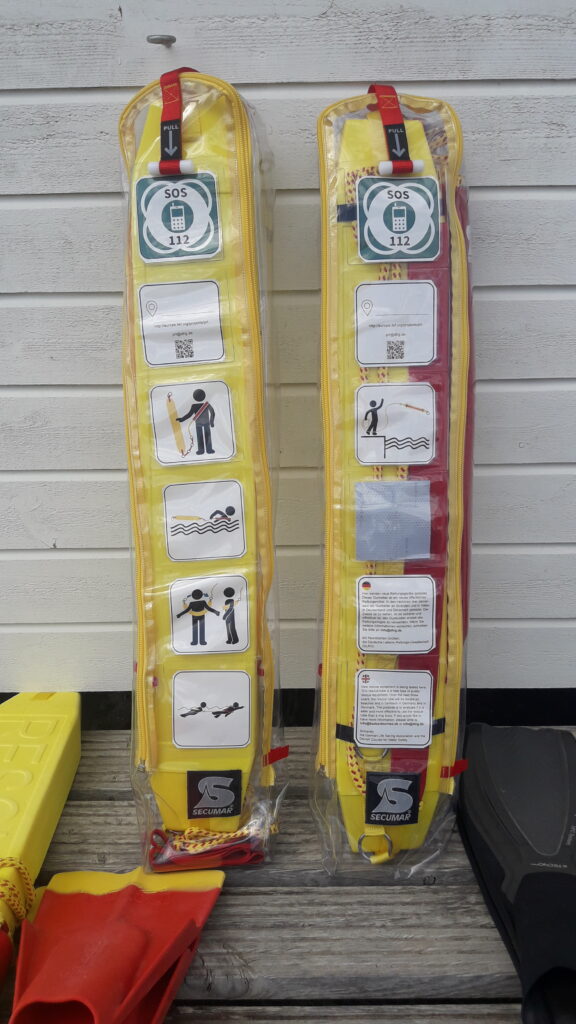The ILSE project ‘Public Rescue Tube’ was finalised. Below you will find some words of thanks and the documents.
“We would like to thank SECUMAR and ILSE for their ongoing support, both in terms of advice and the procurement of replacement test material. We would also like to thank the DLRG Bundesverband for their support in the area of external communication for this project (website, email account, flyer printing etc.). We would also like to thank LifeBoard Denmark for their constructive co-operation and lively exchange of ideas. We would also like to thank the municipalities and tourism authorities that made the location available to us for these tests. I would also like to thank those involved from the local DLRG organisations who kept an eye on the public rescue tubes and also took care of their installation/set-up. And last but not least, I would like to thank the PRT project team Germany, without whom the realisation would not have been possible: Marten Pätzold, Rolf Bergdolt, Frank Irmler and Tim Pollmüller.
Finally, a call to all: in case of emergency, please use our PRTs and share your experiences with us via email to prt@dlrg.de.
Thank you! Sabine Spinde, Project PRT”
Here you will find the final documents:
Below the interim report ‘Public Rescue Tube’, dated August 2021.
August 2020, first information about the project:
Every year, more than 30.000 People die in drowning accidents across Europe and hundreds of thousands are involved in non-fatal drowning accidents.
The project to develop a new rescue device
The German Lifesaving Society and the Danish Water Safety Council formed a research group in 2019, that have designed and modified the rescue tubes that are being tested. The group are in collaboration with the local authorities carrying out the tests at 40 locations in Germany and in Denmark. The International Lifesaving Federation of Europe (ILSE) is funding the project.
What is a rescue tube?
A rescue tube is a flotation device developed for trained lifeguards. It is a lightweight flexible foam tube with a harness and some straps. Providing flotation is the most imminent action to a drowning victim. To avoid drowning, sufficient buoyancy in the water is especially important. The rescue tube gives 105 Newtons of buoyancy.
What about the ring buoy, is it not good enough?
A ring buoy is designed to give flotation and to be used from ships. However, for a rescuer on a beach, it is very difficult to swim with. The rescue tube has similar buoyancy, but is designed to swim with, it is connected to the rescuer and is therefore considered faster and safer for the rescuer to use.
Why testing a new rescue device?
Although there is some evidence that rescue tubes are safer and faster to use for the public in drowning accidents, more evidence is needed, especially how the rescue tubes are used by the public. This test will run for three years, from 2020 to 2023, and an evaluation report will be published thereafter.
Depending on the outcome of the tests, more tests may be carried out, and existing public rescue equipment and advice may be changed or modified.
The safety of the public rescue equipment is important. It is documented that many rescuers drown in their attempt to rescue others. The aim of this research project is to improve the safety of the public rescuer.
Are public rescue tubes used elsewhere?
Yes. In Hawaii and South Africa, public rescue tubes and cans have been available to the public on beaches for several years. Evidence from both these countries shows that the rescue tubes and cans have been used by the public in rescue situations in the water.
Where are the public rescue tubes tested?
The public rescue tubes are intended for all sorts of accident types, locations and water temperatures
• The public rescue tubes are being tested on both beaches at seaside, in lakes, rivers and in harbours
• A modified throwable version is used for harbours and dams, were it is not safe for the rescuer to enter the water
• Drowning accidents takes place all year around, so the public rescue tubes will be positioned permanently throughout the year.


